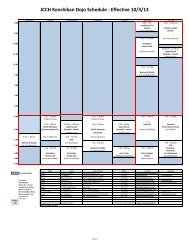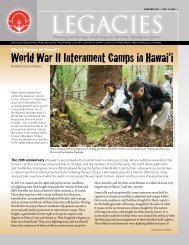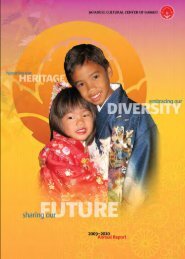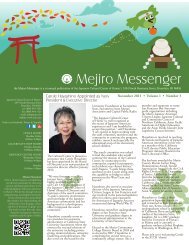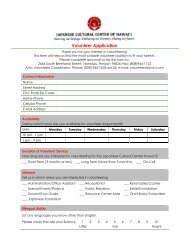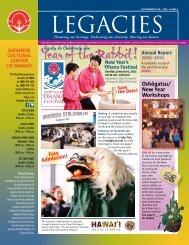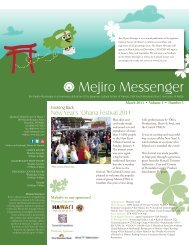Legacies - Japanese Cultural Center of Hawaii
Legacies - Japanese Cultural Center of Hawaii
Legacies - Japanese Cultural Center of Hawaii
Create successful ePaper yourself
Turn your PDF publications into a flip-book with our unique Google optimized e-Paper software.
JCCH Receives a<br />
Gift from the<br />
Daniel K. Inouye<br />
Legacy Fund<br />
A special gift to the <strong>Japanese</strong> <strong>Cultural</strong> <strong>Center</strong> <strong>of</strong><br />
Hawai‘i from the Daniel K. Inouye Legacy Fund<br />
is now on display in the JCCH administrative <strong>of</strong>fice.<br />
Fundraising Campaign For Sadako’s Crane<br />
The public is invited to join in a special opportunity to<br />
support a permanent exhibition <strong>of</strong> one <strong>of</strong> Sadako Sasaki’s<br />
paper cranes in Hawai‘i.<br />
In August 2012, the National Park Service and Pacific<br />
Historic Parks announced a special donation <strong>of</strong> one<br />
paper crane given by the family <strong>of</strong> Sadako Sasaki to<br />
be displayed at the World War II Valor in the Pacific<br />
National Monument at the USS Arizona Memorial.<br />
The Sadako Crane Hawai‘i Fundraising Committee is<br />
chaired by Wayne Miyao, Chairman <strong>of</strong> the Hiroshima-<br />
Hawai‘i Sister State Committee, Carole Hayashino,<br />
President and Executive Director <strong>of</strong> the <strong>Japanese</strong><br />
<strong>Cultural</strong> <strong>Center</strong> <strong>of</strong> Hawai‘i and Alton Miyamoto,<br />
President <strong>of</strong> the Honpa Hongwanji Mission <strong>of</strong> Hawai‘i.<br />
To ensure the preservation <strong>of</strong> Sadako’s crane in Hawai‘i<br />
and to properly share her story with visitors to Pearl<br />
Harbor, members <strong>of</strong> the <strong>Japanese</strong> American community<br />
in Hawai‘i have come together with the Pacific Historic<br />
Parks to raise $50,000 for the permanent Sadako Crane<br />
display in Hawai‘i. At this time, the immediate goal <strong>of</strong><br />
the campaign is to raise $38,000 by May 31, 2013 in<br />
order to begin construction and unveil Sadako’s crane<br />
display on September 21, 2013, a day commemorated as<br />
“International Peace Day.”<br />
One <strong>of</strong> the fundraising organizers, Wayne Miyao,<br />
chairman <strong>of</strong> the Hiroshima Hawai‘i Sister State<br />
Committee, said, “Unfortunately, World War II in the<br />
Pacific started with the bombing <strong>of</strong> Pearl Harbor on<br />
December 7, 1941 and ended with the tragic bombing<br />
<strong>of</strong> Hiroshima on August 6, 1945. Through the years,<br />
Hawai‘i and Hiroshima have been linked in war and<br />
tragedy. With this donation <strong>of</strong> a paper crane by the<br />
Sasaki family to Pearl Harbor, we can now be linked in<br />
peace and goodwill.”<br />
Carole Hayashino, President and Executive Director<br />
<strong>of</strong> the <strong>Japanese</strong> <strong>Cultural</strong> <strong>Center</strong> <strong>of</strong> Hawai‘i added, “The<br />
permanent display <strong>of</strong> Sadako’s paper crane is a wonderful<br />
gift to Hawai‘i and an important addition to the World<br />
War II Valor in the Pacific Memorial at Pearl Harbor.<br />
We look forward to building support from our community<br />
and sharing the legacy <strong>of</strong> Sadako Sasaki and her hope<br />
for peace.”<br />
Alton Miyamoto, President <strong>of</strong> the Honpa Hongwanji<br />
Mission <strong>of</strong> Hawai‘i commented, “This is a rare and<br />
exciting opportunity for the people, businesses and all<br />
groups especially all religious denominations throughout<br />
our state to promote peace and join in our fundraising<br />
efforts. We welcome and humbly ask for your support in<br />
promoting the dream and dying wish <strong>of</strong> Sadako Sasaki.”<br />
Sadako Sasaki was born on January 7, 1943 in Hiroshima,<br />
Japan. She was two years old when the atomic bomb was<br />
dropped, was later diagnosed with leukemia and died on<br />
October 25, 1955 at the age <strong>of</strong> 12. Prior to her passing,<br />
Sadako diligently folded paper cranes or orizuru, based<br />
on <strong>Japanese</strong> legend that if a sick person folds a thousand<br />
cranes, her wish would be granted. A monument<br />
dedicated to her memory and as a memorial to all <strong>of</strong> the<br />
children who had died from the effects <strong>of</strong> the atomic bomb<br />
was erected in Hiroshima Peace Park. Today, the origami<br />
crane has become an international symbol <strong>of</strong> peace, and<br />
people, throughout the world, continue to fold paper<br />
cranes with the hope <strong>of</strong> peace.<br />
All monetary gifts to the Sadako Crane Hawai‘i exhibit<br />
are tax-deductible. All contributions are being accepted by<br />
the Pacific Historic Parks at:<br />
Pacific Historic Parks<br />
94-1187 Ka Uka Boulevard<br />
Waipahu, HI 96797<br />
Please notate that your donation is for the Sadako Crane<br />
Project. All donors will be invited to the unveiling or<br />
dedication ceremonies at Pearl Harbor on Saturday,<br />
September 21, 2013, which is “International Peace Day”.<br />
10




